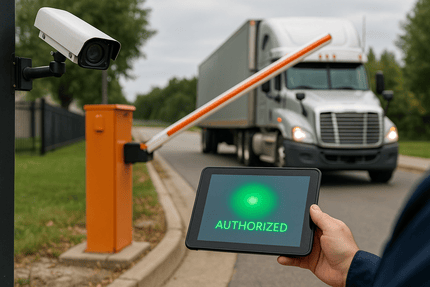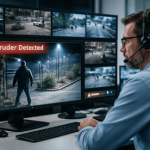
Gate lines are silent profit killers. Every minute a truck waits at the entrance is a minute your yard is not moving freight. The good news is that modern transportation facility security can remove that bottleneck with a zero touch model. By combining License Plate Recognition, telematics, and a lightweight rules engine, you can automate gate decisions, harden perimeter control, and speed up the flow of vehicles without sacrificing accuracy or auditability.
At SSP, we build zero touch gate workflows for fleet yards, logistics depots, and mixed use transportation campuses. Below is a practical guide to how the pieces fit together and what to measure once you launch.
k
k
What zero touch really means
Zero touch gates allow an authorized vehicle to enter and exit with no driver action and no guard intervention. The system verifies the plate, checks policy, opens the barrier, and logs the event. If anything is off, the gate holds and a clear exception workflow starts. The driver stays in the cab and your team focuses on exceptions instead of routine checks.
This model improves transit access control, supports public safety, and reduces congestion at peak times. It also creates cleaner data for investigations, compliance, and planning.
k
k
The three building blocks
1. License Plate Recognition at the perimeter
High quality LPR cameras capture plates at approach, under poor lighting, rain, or dust. The image is parsed in real time and matched to an allow, deny, or watch list. In a fleet yard access control design, you will want front and rear coverage, an optimized angle, and a capture zone that begins before the stop bar.
What LPR contributes
-
Fast identification with no driver action
-
Time stamped, searchable vehicle logs
-
Immediate alerts on unknown or blacklisted plates
2. Telematics and GPS from the vehicle
Telematics confirms that the vehicle presenting at the gate is the scheduled unit on the expected route. For leased carriers or visitors, you can rely on pre authorization rules instead. For owned fleets, telematics adds powerful context.
What telematics contributes
-
VIN, driver assignment, and route confirmation
-
Geofence entry and dwell time tracking
-
Exception flags such as unscheduled arrival or route deviation
3. A rules engine that makes the decision
The rules engine is the brain. It evaluates the LPR result and telematics data against policy. Think of it as a checklist that runs in milliseconds.
Common rules
-
If plate is on the authorized list and time is within delivery window, open
-
If plate is authorized but telematics shows route deviation, hold and notify
-
If plate is unknown after two reads, route to intercom and secondary camera
-
If site is in lockdown or weather alert, hold all except emergency vehicles
The result is a consistent, auditable decision every time.
k
k
How the workflow runs in real time
-
The camera reads the plate at the approach zone.
-
The system looks up the plate in the current allow or deny lists.
-
In parallel, telematics confirms the unit, route, and driver status.
-
The rules engine makes a pass, hold, or escalate decision.
-
The gate opens automatically for pass.
-
For hold, the intercom panel opens a two way call and operators see the correct camera angles.
-
Every step writes to a unified log that ties video, access decision, and telematics into one record.
This workflow extends to exit lanes as well, which lets you validate dwell time, load verification, and yard capacity.
k
k
Why zero touch outperforms manual checks
-
Throughput
Faster recognition and automatic barriers reduce average gate time from minutes to seconds. Many sites see peak hour lines drop significantly once exceptions become the only manual cases. -
Accuracy
Plates do not get misheard and timestamps are exact. Rules apply equally across shifts and never degrade with fatigue. -
Security
Transportation facility security improves when every entry and exit is verified and logged. Linking LPR to a rules engine reduces tailgating, piggybacking, and credential sharing. -
Operator focus
Staff handle exceptions and safety, not routine lift and log tasks. This is essential for 24 by 7 operations with lean teams.
k
kk
Designing your allow and deny strategy
A strong list strategy will make or break the first month of deployment.
-
Tiered authorization
Separate owned fleet, frequent carriers, scheduled vendors, and ad hoc visitors. Each tier gets distinct rules for time windows, zones, and escort needs. -
Time bound entries
Pair plates with appointment windows. Outside the window, the rules engine can hold, route to staging, or require supervisor approval. -
Temporary passes
Use short lived entries for contractors and loaner vehicles. Expiration and geofence restrictions protect you if a plate is copied or reused. -
Watch and notify
Create a watch list for plates tied to unpaid claims, previous incidents, or mismatched paperwork. These do not automatically deny but do raise an operator alert.
k
k
Data that improves operations
Zero touch gates do more than open barriers. They generate clean, structured data that helps you run a better yard.
Track these metrics
-
Approach to open time by lane and by rule outcome
-
Dwell time by carrier and by route type
-
Percentage of exceptions and top exception reasons
-
First read success rate for LPR cameras
-
Unauthorized approach attempts and time of day patterns
Share the wins with your operations team. When they see gate cycle time drop and appointment adherence improve, adoption grows quickly.
k
k
Integrations to plan from day one
-
VMS and public transit surveillance
Link the VMS to gate events so the correct camera clips auto attach to each record. -
Access control and alarms
Treat the gate like any controlled entry. If a barrier is forced or a vehicle tails through, the system raises an immediate alarm. -
Yard management, WMS and TMS
Pass arrival and departure events to your yard or warehouse systems. Accurate time stamps improve dock scheduling and labor planning. -
Dispatch and emergency communications
Tie holds and lockdowns into mass notification so security and dispatch are aligned during severe weather or incident response.
k
k
Site design considerations that matter
-
Lighting
Stable, even light improves recognition. Avoid hot spots and headlight glare. -
Camera placement
Keep angles tight, avoid plate tilt, and set read zones before the stop bar so braking does not obscure the plate. -
Network and power
Provide redundant power and edge buffering so reads continue during brief outages. This is essential for true 24 by 7 reliability. -
Bypass and safety
Include a manual bypass with logged use and a clear policy. Safety loops and presence sensors should be tested on a fixed schedule.
k
k
Where this fits in your security strategy
Zero touch gates strengthen the perimeter while supporting operations. They complement interior access control, warehouse surveillance, and emergency communication systems. For airports, they help segment airside and landside traffic and support airport terminal protection. For transit depots and logistics hubs, they deliver faster, safer entries that align with co managed monitoring and 24/7 support.
k
k
Start with a pilot, scale with confidence
Most sites succeed with a single lane pilot that runs for 60 to 90 days. Pick a lane with a stable flow and a mix of owned and partner vehicles. Measure cycle time, exception rate, and operator workload. Refine your rules, then expand to other lanes and exits.
SSP designs and supports zero touch gate solutions that combine LPR, telematics, and a rules engine into a single, auditable workflow. If you want to reduce congestion at the perimeter and strengthen transit access control without adding headcount, we can help.
Discover how SSP keeps transportation systems secure and operational.
Contact us to schedule a gate workflow assessment and design session.


